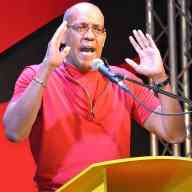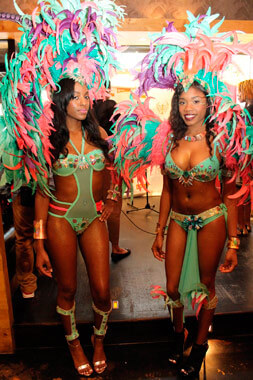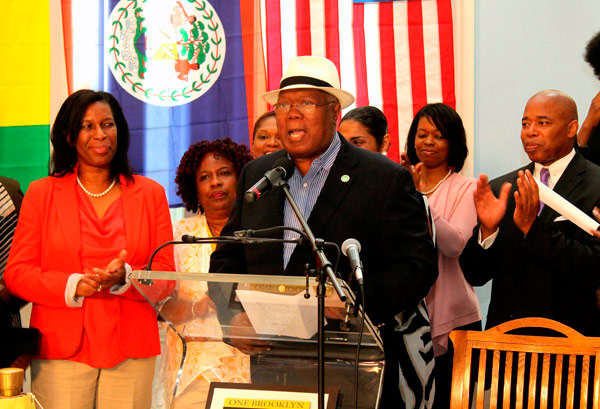Carnival mas in Brooklyn has always been colorful and flashy; people come from all over the country and the globe to see it. However, there has been a debate raging in recent years as to whether or not the Brooklyn Caribbean Carnival has been losing its value, sense of tradition and culture to skimpy costumes, vulgarity and violent behavior. Mas camp designers Marlon Smart and Uncle Percie from “Ramajay Mas Inc.,” Pat Nurse from “Carican Costumes” and Toni Barnette from “D’Midas International” all believe that mas has changed.
According to Smart, people who come out on the Parkway have a strong misconception of what mas really is. “Back home in Trinidad, when people come out to play mas, it’s fun,” says Smart. “However, it’s also something deep, it’s something spiritual, it’s something inside of you. However, when one looks at what happens on the Parkway, with the younger generation, they come out to play, but then they’re on the ground, wearing next to nothing, opening up their legs and doing all kinds of crazy stuff.” “Mas is meant to be farewell to the flesh before Lent. There is a historical element to carnival. Before Lent, people would come out to release their inhibitions and then go to church. It’s not about coming outside to be vulgar and commit crimes. The problem is that all many of them know is Eastern Parkway. All they know is what they have seen on the news of vulgarity and violence. There needs to be a re-education and a going back to the roots of what Carnival is about.”
However, there are those who feel carnival can only go forward with the creative innovation of the present and hopefully some of the values and tradition of the past. “One can never go back because life is about change and evolution. The culture of mas can only move forward. That is the progression of life,” says Uncle Percie. “I believe that we go from step to step and in that, unfortunately, knowledge can be lost by the younger generation. This is what made artists like Peter Minshall special because he is able to bridge the past and present. With Minshall’s designs, you can see the marriage between the traditional and the modern. Unfortunately, today in mas, there are just a lot of panties and bras like what we may see in Brazil.”
Pat Nurse from “Carican Costumes” believes that there is definitely a need for re-education about mas, it shows even in the revealing nature of some of the children’s costumes she has seen. The attitudes of people on the Parkway sometimes result in violence. She said, “If I bump into you, it shouldn’t be taken as an offense that erupts into violence. After all, there’s tens of thousands of us out here. Instead it should be taken as an opportunity to gain a friend. This is how it is still in Trinidad. It’s about sharing the spirit of carnival. It is meant to be a time of connection, celebration and liberation; not what we have been seeing in recent years.”
Toni Barnette of “D’Midas International,” who has been involved in mas since 1999, has seen the transition between then and now. She conceded, “Don’t get me wrong, the costumes still look pretty, but there has been a loss of direction and the reason for it is that many of the elders are dying out and a new generation is taking over. Times are changing, mas is also changing with the times and to be honest in this day and age, sex sells. It’s the climate we’re in. Many of us in this generation like the beads, the feathers and the wire bras.” As far as going back to the origin of mas, Barnette believes that a major barrier to that is money.
Mas like Hip-Hop started off with messages of heritage, culture and love for self, but over the years, the messages of both institutions have morphed into something different. According to Barnette, “For many designers in mas, like many Hip Hop producers, it’s all about the money right now. When I was playing in the early 2000s, it was still about the heritage, culture and love for carnival. But then new bands started coming up and people started seeing how much money could be made and it became more of a business instead of culture. Now it’s who sells the most costumes, who has the biggest band on the road and who comes in the top three. It’s become a big road party where people make their money and leave their culture behind.”
Both Barnette and Uncle Percie, remain hopeful about the re-education and longevity of mas. “There definitely is hope for re-education because there are still elders here who can teach the younger generations exactly what carnival is about,” says Barnette. You have people who want to start a section because they see the money. Is that your only motive? Should it be? What is your section representing? If people are taught by the elders to examine that, mas can begin to get back to where it’s supposed to be.” Uncle Percie also remains hopeful to the longevity of carnival, “Carnival will not die. It will go on. I was born in it and I grew up in it. Now my children are in it and will carry it on. No matter how the costumes transition and the fabric decreases in the costumes, carnival mas will continue to go on.”

























